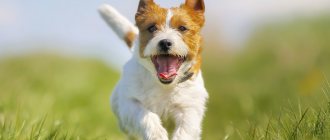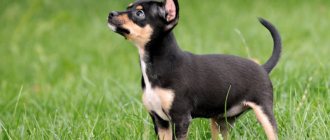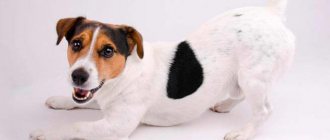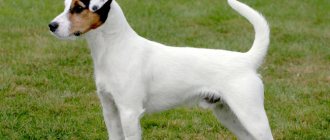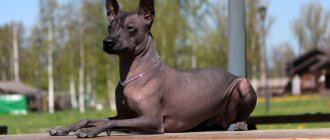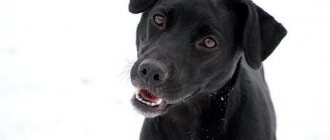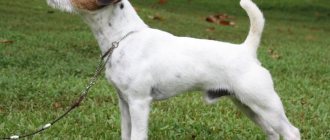The Jack Russell Terrier is originally a hunting dog breed.
She is distinguished by her instant response, activity and friendliness.
Nowadays, this dog has become an excellent companion for people who do not sit still and lead an active lifestyle.
In this article we will talk about Jack Russell puppies - how to choose them and how to care for them. We will also show you photos of these cute babies.
Brief information about the breed
Dogs of this breed were bred in Great Britain for burrowing . The breed combines small size, strength, courage and powerful jaws. All this was needed to penetrate the hole and grab prey.
NOTE!
The breed is named after the English pastor John Russell from Devonshire. He was very fond of horse hunting, and it was he who first described these dogs.
Nowadays, the Jack Russell Terrier has an average weight of 5-7 kg, and a height at the withers of 25-31 cm. The skull is slightly narrowed towards the eyes. The eyes themselves are shaped like almonds, dark and deep-set. The chest has a girth of 40-43 cm, the tail is docked. The life expectancy of dogs of this breed with proper care is on average up to 14-15 years.
From the first days, Jack Russell Terrier puppies are characterized by excessive activity and a desire to dominate their owner, therefore, in order to turn a Russell into a well-mannered dog, you will have to make a lot of effort. Raising a Jack Russell should take place without shouting and beating, but at the same time without indulging in all the dog’s pranks, which will turn the puppy into a real little devil in the future.
To prevent bad behavior, you need to stop any antics of your pet, not be touched by his pranks, and not allow the dog to become the main one in the house and manipulate you.
Weight table by month
This chart of average puppy weights and heights will help you keep track of the development of your little Jack Russell Terrier.
| Age (months): | Weight (kg): | Height at withers (cm): |
| 1 | 0,7-1 | 8-9 |
| 2 | 2,5-3 | 10 |
| 3 | 4 | 11 |
| 4 | 4,1 | 12 |
| 5 | 4,3 | 13 |
| 6 | 4,5 | 15 |
| 7 | 4,6 | 17 |
| 8 | 4,7 | 19 |
| 9 | 4,8 | 20 |
| 10 | 4,9 | 22 |
| 11-12 | 5-6 | 25-30 |
Small deviations from the given values (within 100 g, 1-2 cm) are not dangerous, either more or less - this is the individualized development of the dog. The owner should be concerned about a significant difference: too rapid growth, developmental delay, deficiency or excess weight of the animal.
Breeders and professional owners also use a simple formula for calculating the ideal weight for their pets: per 5 cm of height (meaning height at the withers) - 1 kg of weight. Thus, a three-kilogram dog should not be lower than 15 cm. And for a 30-centimeter dog, the suitable weight is within 6 kg.
What do newborn puppies look like?
Puppies are born blind, their muzzle and body do not yet have the proportions of an adult dog, so it is not yet possible to judge their future appearance. This can be done much later.
The puppy's coat already has a color that will remain in the future. The tail is pressed to the body, the ears puff up. The tip of the nose and paws are pink or pinkish in color. The type of coat is not yet clear.
Jack Russell puppies are 14-16 cm in size at birth. Weight usually exceeds 200 g and ranges from 200 to 250 g.
These indicators are not universal, they depend on:
- heredity;
- the period at which the puppies were born;
- number of puppies in the litter.
Development by months
At one month the puppy already has its first teeth:
- fangs;
- incisors;
- the first and second false-root ones.
He begins to emerge from his den along with the other puppies.
This is the time when you need to start toilet training your dog. During the first month, the breeder observes an increase in the puppy’s activity and how he gets used to his name. The dog develops a daily rhythm.
IMPORTANT!
At the age of 45 days it is recommended to brand the puppy. At this time, the baby is also already accustomed to hygiene procedures - combing, cleaning the ears and examining the teeth.
The puppy continues to explore the world. Closer to the age of two months, he begins to better remember commands, chew and ruffle objects around him. He is growing and gaining weight, but at this age it is still impossible to see the puppy’s shortcomings.
Further development occurs in the following order:
- At 2-2.5 months, the puppy begins a period of fear. At this time, you need to communicate with him as much as possible and avoid things that would frighten the dog. Also at this time the puppy is already switching to food. At 2 months, the puppy begins to bark and all of his baby teeth appear. This is the right time to start accustoming him to trips and walks. The dog continues to grow and gain weight;
- from 2 to 5 months, the proportions of the dog’s head and body are determined. Character and teeth change;
- at 3 months the dog is already ready for independent life. During these three months, his individual character traits are formed;
- from 4-8 months the dog begins to want to run away from its owner. This is the time for the dog's "sexy" games. The optimal age to move to a new family. The puppy is fully formed and after changing teeth the bite is visible. At this age, the dog’s character, its preferences and habits are visible;
- at 7-8 months the dog’s growth stops;
- at 8-9 months the dog’s teeth finally change. Fangs that have not fallen out need to be pulled out;
- from 6-10 months the bitch begins her first heat and puberty begins. Males mark their territory and raise their paw;
- 6-12 months is a time of fear of new situations. A new trusting relationship is formed between the dog and the owner. During this period, you should not force the dog to approach the object that it is afraid of;
- at 12 months, the dog completes the formation of the “dominance-submission” relationship.
Types of puppies
In newborn puppies, it is not yet clear what type of coat the puppy will be. This can only be understood when the puppy reaches 3 months.
One way or another, Jack Russell Terrier dogs are divided into three types based on coat type:
- smooth-haired – the coat is close to the body, the undercoat is dense;
- long-haired or wire-haired – hard and long hair that does not adhere to the dog’s body;
- intermediate or brocken - the dog does not grow eyebrows or a beard, the length of the coat is longer than that of other types, but it is adjacent to the body, and does not bristle, like long-haired dogs.
Care and maintenance
Jack Russell Terriers are not fussy in their maintenance. It is worth noting that dogs have strong immunity and health. Basic care consists of several points:
- wool requires regular brushing;
- dogs need to be bathed;
- requires standard care, like any pet - cleaning ears, trimming nails.
The short hair of dogs requires simply combing, without trimming. During shedding, scratch your pet more often; the old fur will be replaced by a new one faster. Water procedures should not be frequent, once every week and a half is enough.
Jack Russell Terrier is a lively and mischievous breed
Do not allow water to get into your ears, as this can cause otitis media. For convenience, you can close the ear openings with cotton swabs. Wash your paws after every walk. Monitor the condition of your teeth and gums and visit your dentist weekly. In case of any inflammation, do not delay your visit.
Plaque is a common occurrence if the dog eats natural or wet food. Special bones or brushing with veterinary toothpaste will help get rid of it. The ears of Russell Terriers require special attention. It is necessary to wipe them with an anti-allergenic solution and clean them from contamination.
Features of care
Before the puppy comes into your home, prepare the space - remove small objects and wires, as well as other things that could harm the baby, from visible places. Remove personal and expensive items that could be damaged.
Prepare a place for the puppy. There should be no drafts, windows, or heating objects near it. Try to make it a place where the dog is at peace. If you need to isolate your baby for a while, use a playpen, cage or enclosure.
As soon as the puppy appears in the house, show him who is the boss. Designate an area where he can play, sleep, eat, and where he should stay away. It is better not to retreat from such tactics. Raise your puppy from the first days, while he is still trainable.
There should always be toys in the Jack Russell's personal place that will distract him while you are busy with your business or while you are relaxing.
Train him to toilet in a timely manner - usually after sleep or after eating. Buy a special diaper at a pet store. As soon as you notice the puppy’s anxiety, show him a place to relieve himself.
After the required vaccinations, you can accustom the puppy to the street. To do this, use an already used diaper - the dog will react to the smell.
The first walks should be no more than 10 minutes. As the puppy grows, increase the time. Even if the weather is bad outside, be sure to take the puppy out, at least so that he can go to the toilet.
Don't forget to play active games with your puppy during walks. Stop your puppy from chasing other dogs and cats. Teach him discipline.
Brush your puppy several times a week. During molting season - daily. Puppies with long hair will have to be taken to a grooming salon. Teach your baby to behave calmly during hygiene procedures.
NOTE!
Don't forget to clean your puppy's ears and trim his nails. If necessary, rub your eyes. To care for your teeth, purchase a special brush from a pet store.
You can bathe the puppy after scheduled vaccinations, when two weeks have passed. This breed does not need to be washed frequently, but only with special shampoos. On average, Russells are bathed three times a year.
Read about other features of Jack Russell care here.
What should the diet be like?
In the first few weeks that you have a puppy, you should feed it the same as the breeder fed it, gradually transitioning it to the desired diet .
If you plan to feed your Jack Russell with industrial food in the future, then choose premium or super-premium products.
If you want to feed your pet natural food, then begin to gradually introduce the following products into his diet:
- meat;
- fish;
- dairy products;
- cereals;
- vegetables and fruits;
- eggs.
For 1 kg of puppy, 20-30 g of meat per day is required.
Ideal meat choices include beef, turkey and chicken breast. Shred the beef before serving, but you will have to cook the chicken and turkey.
A couple of times a week you should give fish, but only sea or ocean fish. Before serving, boil and remove bones.
At first, small puppies should replace cow's milk with 10% cream diluted with water. Calcined cottage cheese can also be an alternative. It should be given several times a week, 30-50 g.
You can start your first complementary foods with buckwheat and rice porridges.
The Jack Russell digests carrots, beets, zucchini and pumpkin best. During the season, you can add a little greenery to them.
You can give an apple as a fruit. You can give other fruits if the puppy is interested, but you should avoid feeding citrus fruits .
Sometimes give your puppy an egg omelet, but no more than 1-2 times a week.
What to feed a Jack Russell Terrier puppy
The dog is small in size. Therefore, the volume of feed must be calculated so as to provide the required amount of energy and avoid excess weight in the animal.
The owner must decide for himself what kind of food he will choose for the puppy - dry or natural. As soon as the baby is brought home, you should not immediately offer him new food. During the adaptation period, it is better to feed him the same food as the breeder for at least 10-14 days.
Ready-made feeds are already balanced in composition. Available in dry and semi-liquid form. For a puppy, select only specialized food for dogs up to one year old.
Natural nutrition is a combination of proteins (meat, eggs, fish), vegetables and cereals. This ensures normal growth, intestinal function, and shiny coat. The number of parts should be 2:1:1.
How to feed?
The Jack Russell should eat from a bowl on a special stand that can be adjusted as the puppy grows.
Don't feed him from the table, even if he asks. Accustom your dog to a routine - to eat in a certain place at a certain time.
If you decide to feed your puppy natural food, make sure that he receives all the necessary substances and that the diet is balanced.
CAREFULLY!
Do not give your puppy sweet, pickled, smoked, fatty or salty foods. This will lead to health problems.
Food should be at room temperature.
From 4 months, you need to feed your puppy six times a day, reducing the number of feedings every month. After 9 months, the dog should eat 2 times a day.
Make sure your dog always has fresh water at room temperature.
Factors influencing growth
It is much easier to ensure the harmonious development of your Jack Russell Terrier if you know the main factors affecting the pet’s height and weight. Their most serious influence is in the period from birth to 1 year of life.
Thus, developmental delay is most often caused by the following:
- Congenital, hereditary diseases.
- Poor quality, insufficient, low-calorie nutrition.
- Poor living conditions - cold, damp, drafts, constant noise, systemic stress.
- Worm infestation.
- Poor living conditions for the mother dog during pregnancy and lactation.
- Untimely, incorrect introduction of complementary foods, too early weaning from mother's milk.
- Insufficient level of lactation in the mother dog during the suckling stage of the puppies' life.
- Lack of supplements of vitamins and microelements necessary for cuties.
- Insufficient or, on the contrary, excessive, debilitating physical activity.
To restore the harmonious development of the puppy, it is better not to let the problem take its course, and not to try to fix it yourself without the necessary education and experience. The best option is to seek help from a veterinarian. Depending on the source of the problem, the solution is found:
- Deviation from the norm during the suckling period. The kitten is placed on the dog's rear nipples, where more milk collects. This situation is typical for multiple litters: stronger puppies push the weaker ones away from the nipples. If there is not enough milk for everyone, then artificial nutrition is introduced and a nurse dog is found. When the puppies are already grown up, with the approval of a specialist, they are introduced to complementary foods ahead of schedule.
- Underweight after purchasing a puppy. Perhaps this is how stress affects the baby - a new home, separation from his mother and siblings. The new owner must surround the baby with attention and care, adjust his diet: add calcined cottage cheese with one yolk, a couple of spoons of whey and 2 drops of a multivitamin.
- Developmental delay is a consequence of helminthic infestation. If the conditions for keeping the animal are ideal, the diet is correct, the reason for the low weight may be helminths. The necessary tests are carried out, the puppies are prescribed Dirofen, Prazitel, Helmintal, etc.
First vaccinations
At 21 days, the puppy and mother are dewormed. This is usually done with a suspension of Drontal Junior, Pirantel and other drugs.
At 4-6 weeks they are vaccinated against distemper and parvovirus enteritis.
At 3-9 weeks the following vaccinations are given:
- repeatedly from plague and parvovirus enteritis;
- from hepatitis;
- from parainfluenza;
- from leptospirosis.
At 12 weeks, revaccination against distemper, hepatitis, parvovirus enteritis, and leptospirosis is carried out. Vaccination against rabies is carried out.
At 6-8 months after changing teeth, revaccination against distemper, hepatitis, parvovirus enteritis and leptospirosis is carried out.
Price range
How much does a Jack Russell puppy cost?
The highest price for a dog is set when the dog is 5-6 months old. The lowest price is for a puppy one and a half months old.
This is explained by the fact that both its advantages and disadvantages are already visible in a grown-up puppy. If you take a baby, you are literally playing the lottery.
Based on this information, the standard price range for a Jack Russell Terrier puppy ranges from 20 to 40 thousand rubles, taking into account pedigree and vaccinations and provided that you take the puppy from an experienced breeder.
If this information is not important to you, then in this case the price for a Jack Russell starts at 10 thousand rubles.
What to feed a newborn Jack Russell Terrier puppy
A puppy up to a month needs almost daily intake of dairy products - milk and cottage cheese. Gradually, by 3-4 months, the volume and frequency of their intake will have to be reduced. This is due to the fact that adult animals develop an aversion (intolerance) to milk protein.
It is best to use goat milk, as its composition is very similar to dog milk. If this is not possible, then the nutritional value of cow eggs can be improved by adding a quarter of a homemade raw chicken egg. The baby is not allowed cheese, but up to 20 grams of cottage cheese per day is beneficial.
Meat products are given in pureed raw form - starting from the tip of a dessert spoon. Then they give you half, then the whole. To avoid problems with the digestive system, vegetables are given boiled or baked, pre-chopped.
In terms of time, a Jack Russell puppy is fed every three hours. Before going to bed, it is better to give not vegetables and milk, but more nutritious meat, which will allow the animals to sleep better and withstand the night break in feeding.
How to choose a puppy?
As with many breeds, the Jack Russell has certain standards that you need to familiarize yourself with so as not to be deceived.
You also need to pay attention to the following:
- the puppy should be active and mobile, look cheerful. Avoid shy and indifferent dogs;
- length and height should be proportional. The puppy's structure should be proportional;
- According to the standard, the dog's head should be of medium width and taper towards the eyes and ears. The nose should be black, the eyes should be black almond-shaped, and the jaw should be strong. The ears should be V-shaped and close-fitting;
- check the dog's appearance and proportions. Are there any external defects? The puppy must have an athletic appearance;
- from the rear, even a puppy should look strong and muscular. The tail should be set high. A healthy puppy always wags him happily;
- pay attention to the wool. If the puppy is smooth-haired, check for fine spots. A long-haired puppy or brocken should not look fluffy. 51% or more of the color must be white. Acceptable colors are red, black and brown shades;
- The puppy's gait should be lively and even.




